Projects
Project Editor: Beth Klopping, English 418/818, Fall 2005
WOMEN IN SPORTS
In the Yearbooks
Yearbooks prove to be an interesting ground for the battle over women's clothing. Through the photographs and text within their covers, we can watch this story unfold and glance at what it meant to be a female athlete at the beginning of the twentieth century.
The University of Nebraska has always taken its football seriously, and the equation between athleticism and masculinity shows itself in the following text, which appeared on page 41 of the university's 1913 yearbook:
"ATHLETICS is the University's compromise with Nature. The University demands that her sons work, Nature demands that they play. The resultant of these opposing forces is that which is neither work nor play, athletics. You will find by consulting either Dr. Alexander or the Standard Dictionary (preferably Alexander) that this name came from a Greek word meaning the natural, spontaneous recreative games by which the exuberant youth give vent to their animal spirits. We know now that it's part of the evolutionary process. Nature has decreed that response to these play-longings shall fit her boys for the work she has in store, when they are to enter contests where there are no referees and battles without umpires. The Greeks, however, even if they weren't evolutionists, considered recreation the function of athletics.
But the Greeks, as even Professor Dan will tell you, had the wrong idea. As they did not live in a business age, they could not realize the amount of advertising a college can get out of a good football team. They never stopped to think how far the already best prepared athletes can be further developed by concentrating coaches on them, nor what splendid lung training the bleachers may give to the weaklings. Consequently the Olympics, from our point of view, were as good as wasted. The merits of no institution of higher learning were in any wise thereby exploited. They gave their heroes, instead of substantial winter clothing decorated with block letters, little dinky tow-bit wreaths.
At Nebraska we are made of sterner stuff. We encourage our strong men to boot the pigskin, and we exhort our weak men to shout. In this way we shall develop a race of men, real men, with red corpuscles and vanadium-steel muscles. They may not, it is true, be able to compete on equal terms with the gorillas, but at least they will be as husky as is safe for us."
|  | | | View Page Image | |
It is against this backdrop that women athletes of the University of Nebraska were portrayed. However, seeking out photographs of these women was not always easy. Sometimes, the few images are organized within a "Girls Sports" section. Other times, they can only be found in a section with a heading such as "Minor Athletics." However, when a "Girls Sports" section does exist, the images on the page that begins that section always give us insight as to how female athletes were viewed that year.
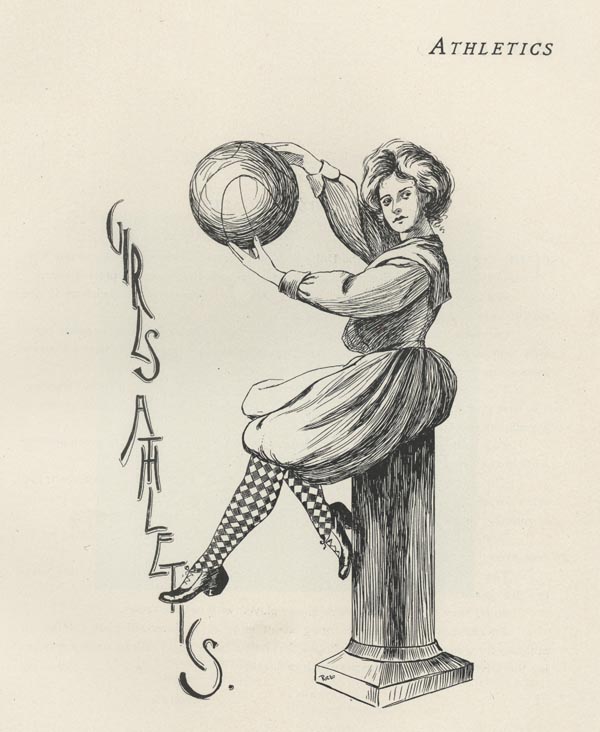
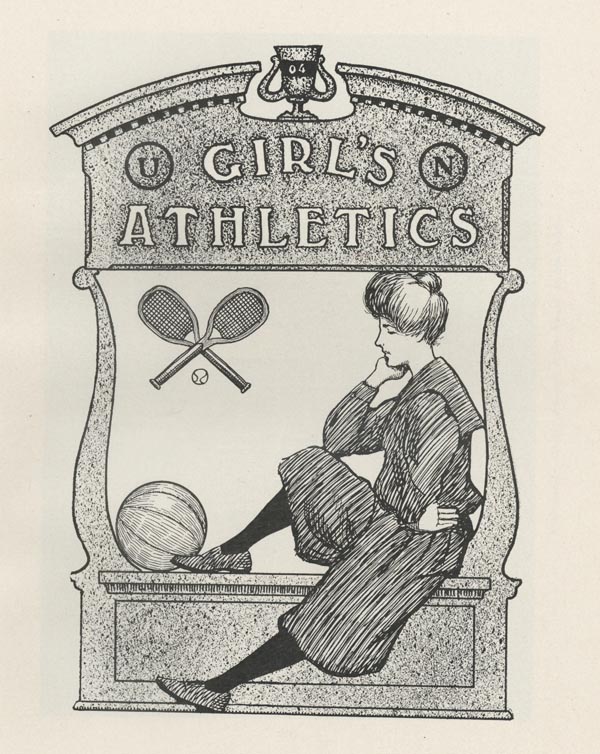
Some interesting issues are raised by these images. In the pages from 1902 and 1904, while sports equipment is present, the athlete is merely posed with it rather than being shown to use this equipment actively. The women in these images appear to be thoughtful and lady-like, with their hair neatly collected, thus removing any trace of masculinity that the connotation of sports may have left. Clearly it was not acceptable, here, to show these athletes in action.
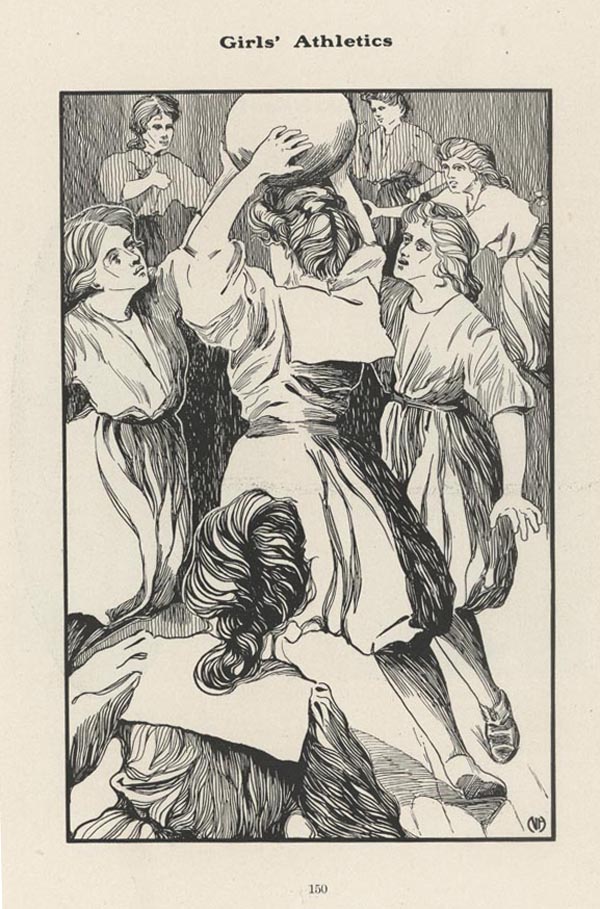
Viewing the image from 1906, however, readers encounter a group of athletes actually playing the sport! Their hair has come loose, their faces are strained, and there seems to be an unprecedented amount of aggressiveness portrayed in the scene. In this image we see female athletes at a moment of true sportsmanship. In contrast to the images in the years before and after, this one is clearly an exception to the hyper-feminized portrayal of female athletes.
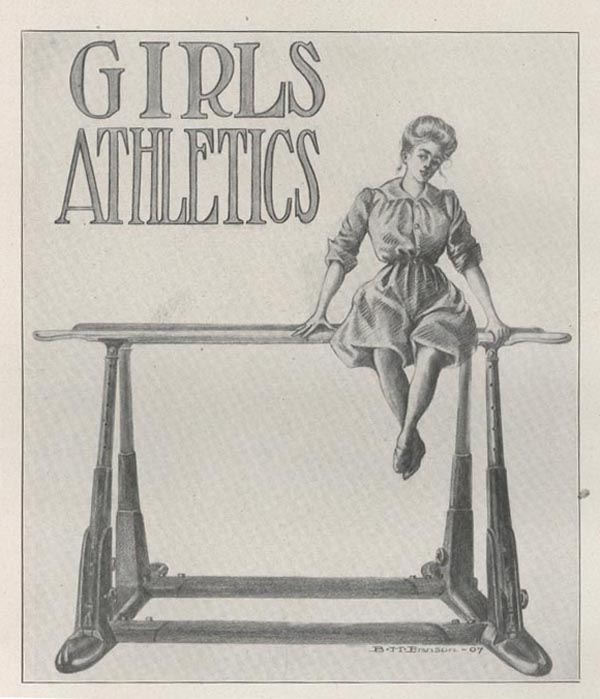
In 1907, the athlete is once again shown as passive and unmoving. Her hair is in its proper place, and it is hard to tell if she has any intention of actually doing any gymnastic work on the equipment shown. The drawing indicates that this woman is more of a bystander than an active participant in her sport. The harsh contrasts in the 1906 image have been replaced with soft shadows and soothing shading of colors.
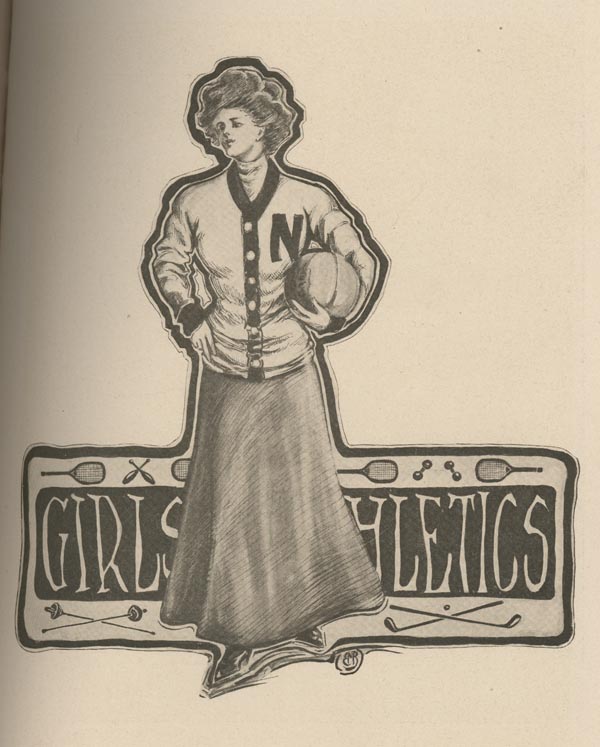
This progression continues in 1908. Here, the athlete is once again thoughtfully posed. Her clothing gives no indication of her activity, rather, it seems, she is just a fan of Nebraska athletics. Her full length skirt certainly does not give the impression that she will be using the basketball in her arms any time soon. Furthermore, in this depiction, the artist was able to emphasize the hourglass silhouette of the athlete.
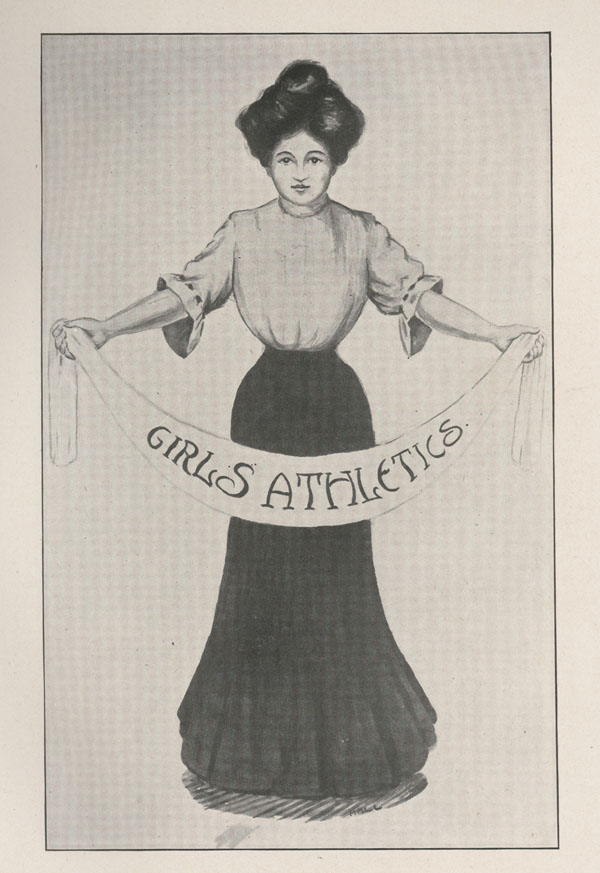
Perhaps the introductory image from 1909 epitomizes the issues at hand. The woman shown in the drawing has been removed of any indication of sports, other than the cloth banner she holds. Since 1908, her dress has been lengthened, and her figure seems to be even more like an hourglass. For the first time, she looks directly at the viewer—a daring act that can only be accepted because her presentation offers no other threat. In fact, this eye-contact seems more modest than confident, due to the submissive attitude conveyed by her clothing.
This explanation, printed in the "Minor Athletics" section of the 1912 yearbook, gives us a better understanding of this struggle between athleticism and femininity in "Women's Gym":
"GYMNASTICS provide about the same opportunities for the co-ed as does drill fro the voting sex-and from all we can gather is enjoyed about as much. The female contingent foregather in the men's gymnasium when the men are elsewhere, clad in bloomers and gum shoes, and there disport themselves under the tutelage of Miss Gittings and Miss Beghtol. Men are not allowed in the room, of course, and to make it easy to determine just when the dears are there, a keyhole about two inches in diameter was put in the east door. A large number of anxious athletes are usually found near the east door, devoid of fear of hatpin accidents, chiefly because hatpins are not worn with bloomers-so we have been informed. Once a year the girl gymnasts have an indoor meet, which only two men have ever witnessed, and they disappeared soon after. However, we opine that it is some meet. The remainder of the year is devoted to Swedish dancing. This is not at all like Spanish dancing, but for some reason great interest always attends a public presentation of the art. Beyond this our reliable information can carry you no farther. Very truly yours."
|  | | | View Page Image | |
This text also illuminates another issue. Women's clothing was not the only controversial topic, here, but also who could see it. Wearing bifurcated pants was considered enough of an attack on femininity. To actually be seen participating aggressively by men was out of the question. Generally, men were not allowed to be present during women's athletic events. The text above, then, hints at the relative awe with which these events were perceived.
"A woman 'should always preserve her inborn sense of modesty and innocence; she must never be seen by the opposite sex when she is likely to forget herself." (Gerber, 12)
In the same yearbook, a similar event is recorded. Under the title "A TRAGEDY," this passage describes an interesting happening at a women's race:
"In a moment the Marathon will begin. Dr. Clapp is making ready to give the starting signal. But horrors! A gruesome tragedy mars the scene. A policeman has dragged the youth away from the knot hole in the fence-for a girls' track meet is not held for the sake of pleasure."
|  | | | View Page Image | |
Of course, the most interesting images in the yearbooks are those of the teams themselves. While the drawings reflected, perhaps, one person's interpretation of the way a female athlete should look, the photographs of the teams show us how the female athletes actually appeared to their classmates.
It is interesting to wonder if perhaps this was the real battleground for women's sportswear at the University of Nebraska. The photographs printed in yearbooks were the most widely distributed representations of female athletes at the time, and, as such, stood ready for criticism from parents, classmates and faculty alike. Therefore it is necessary to remember that these risks were fresh in the minds of the players, coaches and photographers. We can learn quite a bit from looking at the ways in which they decided to present these teams.
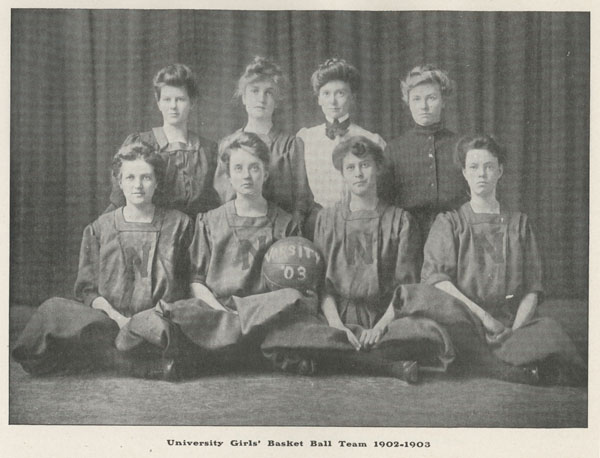
In the above photograph, which was printed in the 1904 yearbook, we see a fair amount of passivity and submission. These players do not look directly at the camera. Their hands rest neatly in their laps, as does the basketball itself. These women certainly do not give the impression that they will challenge woman's place in society.
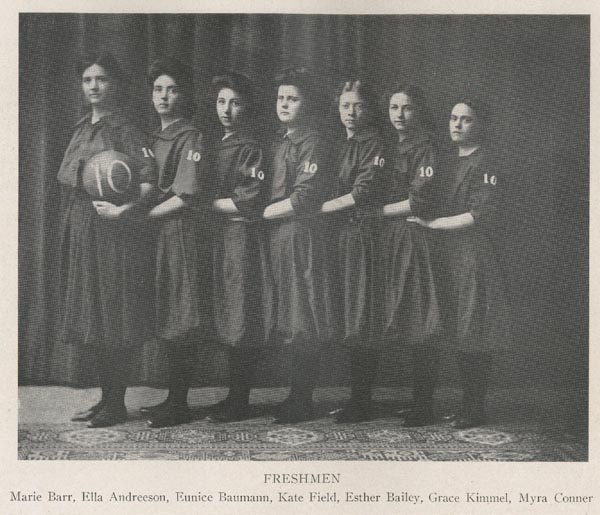
The photograph taken in 1907 is unique because it shows the players standing, giving us a better view of their full uniforms. While they do look at the camera, their positioning detracts from any confidence that eye-contact may convey. Linked to one another with their arms, these players give an impression of a friendly game, rather than any amount of competitiveness.
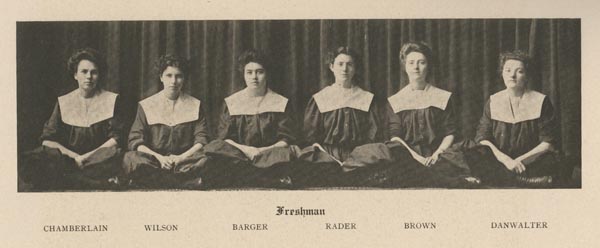
"The sailor collar, a design associated with children's playsuits, is found repeatedly in both bathing and gymnasium costumes. Perhaps encouraging grown women to dress like little boys and girls was a way to reduce the threat of their changing behavior." (Gordon, 43)
The 1908 freshman photograph is accurately explained by Gordon. These broad collars suggest a religious piousness and a childish innocence that actively work to rid the photograph of any challenge to societal systems. The basketball itself, and, in fact, any reference to sports has also been avoided. These women appear more ready to take communion than to run the court.
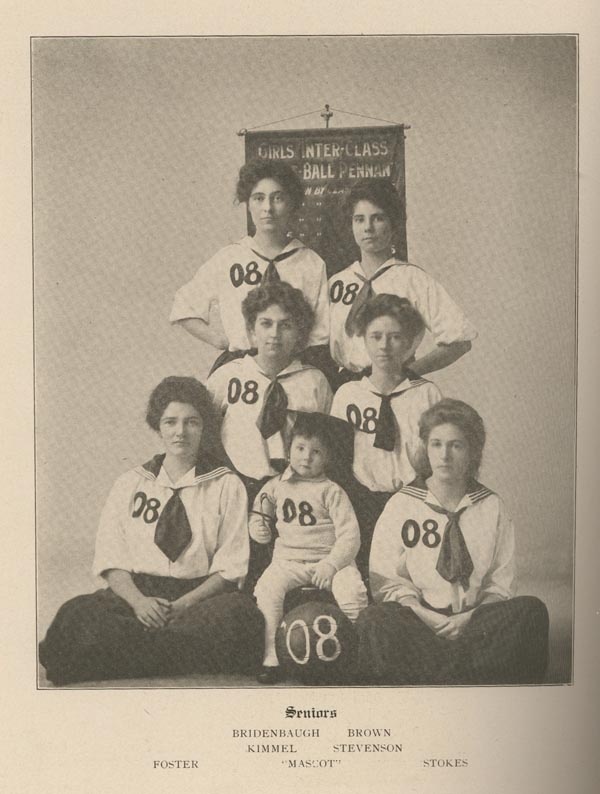
The senior team photograph from 1908 best represents the struggle at hand. While this photograph does include the basketball (and even a banner), allowing the viewer to make the assumption that these women are athletes, the image also is constructed in such a way to remove all doubt that these are still feminine, submissive, domesticated women. Here we see a combination of all the things listed above—minimal eye contact, passive hand placement and juvenile collars—while including the remarkable addition of a toddler! Interestingly, the toddler is placed on top of the basketball, serving as a reminder to the viewer that, above everything, these are women.
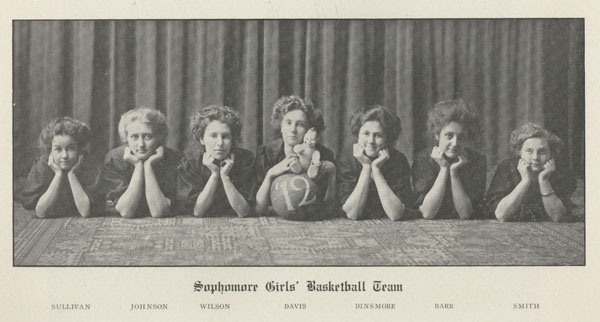
In 1910, we see more of the same. Smiling casually, with their heads resting in their hands, it is barely discernable that this is a team of basketball players. The doll who rests on top of the basketball seems to serve the same purpose as the toddler did the year before. Clearly photographs of women athletes were tricky to design—the women needed to appear submissive and feminine, while still being presented as a group of athletes.
| 
